Esther Williams @ 100: Million Dollar Mermaid
 Tuesday, August 10, 2021 at 10:30PM
Tuesday, August 10, 2021 at 10:30PM Team Experience has been celebrating Esther Williams Centennial with a three part miniseries. Previously we featured Thrill of a Romance and Neptune's Daughter.
In some ways, Million Dollar Mermaid is both the quintessential Esther Williams movie and a departure in the screen siren's career. During the 1940s, Williams achieved cinematic stardom through self-knowing exercises in romantic silliness and musical extravagance, lighthearted productions that wore their escapist possibilities as a badge of honor. One can often feel the screenwriter's strain, trying to shoe-horn swimming scenes in stories that could function just as well without them. Even the baseball comedy Take Me Out to the Ball Game had to be retrofitted into having an out-of-place pool number where Williams gets to lip-sync while swimming under the gaze of Busby Berkeley's camera. Consequentially, MGM never presented Williams as a great dramatic actress, preferring to exhalt her natural charms, radiant presence, and aquatic athleticism.
Loosely inspired in the life of Australian professional swimmer, vaudevillian, and early movie star Annette Kellerman, Million Dollar Mermaid is a lavish biopic with inspirational aspirations...
Existing in the intersection of MGM's prestige fare and the aquamusicals that made Esther Williams into a household name, the picture asks more from her as an actress while also indulging in metatextual readings of her stardom. No wonder it was Williams' favorite of her movies, a box-office hit that originated the actress' nickname and the title for her autobiography. After all, Million Dollar Mermaid is both the story of Annette Kellerman and the story of Esther Williams.
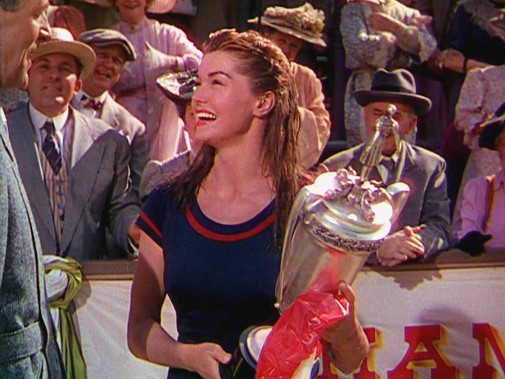
Born in New South Wales, Australia, Annette Kellerman was the Esther Williams of the Silent era. When six, she developed a weakness in her legs that demanded the wearing of steel braces, a disability that her parents tried to circumvent through swimming lessons. The therapeutic efforts paid off in more ways than one. By her teen years, the girl had recuperated the use of her legs, and she soon was a master swimmer, displaying her diving artistry to the public and winning medals for her sporting achievements. She became a practiced entertainer and a celebrity in no time, attempting to swim the English Channel and doing the Danube race against other European swimmers. During these international misadventures, her controversial clothing choices incurred worldwide debate.
Fashion-wise, Kellerman advocated for the right of women to wear one-piece bathing suits instead of the cumbersome traditional costumes with their excess of fabric and pantaloons. The swimmer herself embellished the conundrum in later reminiscing, shaping personal history into myth, into publicity for her popular swimwear line. In other matters, the Australian's celebrity grew as she started appearing on water ballets at the New York Hippodrome and later made her Broadway debut as Undine. Around this time, after having featured in English shorts, Annette Kellerman became a Hollywood actress, specialized in water-based adventures, often with mythological settings. In 1916's A Daughter of the Gods, she appeared fully nude and went on to wear mermaid costumes that inspired what other movie swimmers would don in the future. One of her movies, Neptune's Daughter, was remade into the Esther Williams vehicle Camila reviewed yesterday.
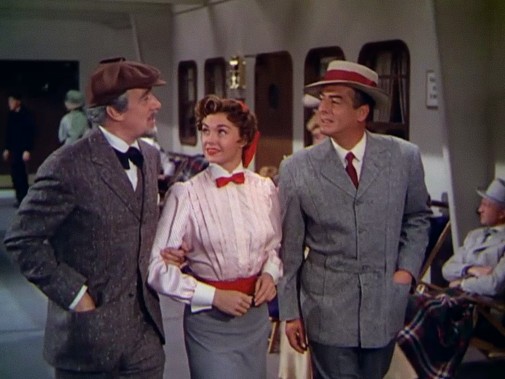
Considering all this, it's no wonder that MGM looked at Kellerman's biography as a sound basis for a movie. The parallels with Esther Williams were immense, and it was she who advocated for the production as far back as 1947. Five years later, her dreams came true, though she had to charm Kellerman into agreeing. The Australian admired Williams' athleticism but thought she was far too pretty for the role. Not that authenticity was a consideration for the filmmakers, mind you. Million Dollar Mermaid is first-and-foremost the Esther Williams show, and Kellerman's story exists only to remodel the actress' comedic persona into a more dramatic and prestigious version of itself. She doesn't even attempt an Australian accent, disconnecting her take on Kellerman from the real woman so thoroughly that any similarities feel almost accidental. What she's got going for her is an ability to perform perfunctory romance with pleasant lightness, notes of effervescence, and even a hint of desire.
Off-screen, Williams was having an affair with one of her movie paramours, Victor Mature, and some of their physical chemistry bleeds into Million Dollar Mermaid. For reference, the actress revealed this, not some mercenary gossiper with a poison pen. Her aforementioned autobiography is full of such details, uncovering a (perhaps excessive) candor that transcends the surface-level shock of a Hollywood starlet shining a light on naughty backstage business. That sometimes dubious, sometimes refreshing, attitude also informed how she inhabited the screen, never allowing the typical biopic beats to drag her down into a pit of joyless melodrama. Even as the screen Kellerman suffers heinous injuries and feels happiness slipping through her fingers, Williams avoids the mannerisms of a noble martyr. Instead, she dazzles the camera with her megawatt smile and illustrates perseverance by way of Hollywood optimism.
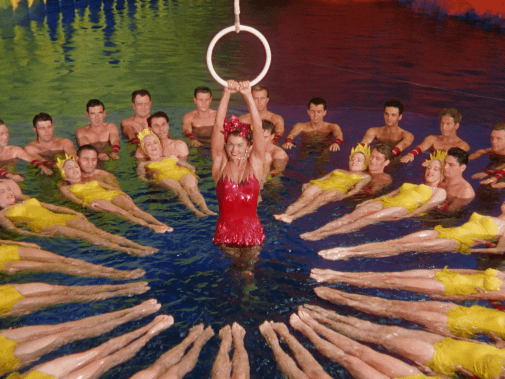
That being said, it's not on land that Williams shines brightest. Indeed, Million Dollar Mermaid features some of the swimmer's most spectacular feats of aquatic showmanship. While Mervyn LeRoy directed the movie, Busby Berkeley was the one to choreograph the water ballets, coming up with such dizzying visions as synchronized diving through walls of colorful smoke, blazing fires, and various pyrotechnics. On another occasion, a ballerina's dance is echoed in an aquatic environment, tutu included, giving a literal meaning to the term water ballet. These passages are so beautifully conceived, so excessive in scale and ornament, that they allow Million Dollar Mermaid to overcome the drudgery of the conventional biography. The numbers feel like Technicolor hallucinations, grand circuses that required elaborate special effects, stunt doubles, and some of the most splendidly appointed water tanks in Hollywood history.
George J. Folsey was justly nominated for a Cinematography Oscar. Still, the sumptuous sets designed by Cedric Gibbons and Jack Martin Smith, Walter Plunkett's anachronistic fantasy of historical fashions, and Helen Rose's musical costumes deserve equal admiration. Unfortunately, as gorgeous as they look, these designs weren't necessarily safe. At one point, Esther Williams dons on a glimmering suit that features metallic sequins and a golden crown. She's hydraulically lifted out of the water in a small platform hidden by foamy jets. When swan-diving from that position, Williams felt the effects of many past eardrum ruptures and lost her balance. During the jump, she realized something was wrong, but it was too late. The aluminum headdress snapped her head back upon hitting the water's surface and something popped in the star's neck. Incapable of moving her upper body, she had to be fished out of the pool.
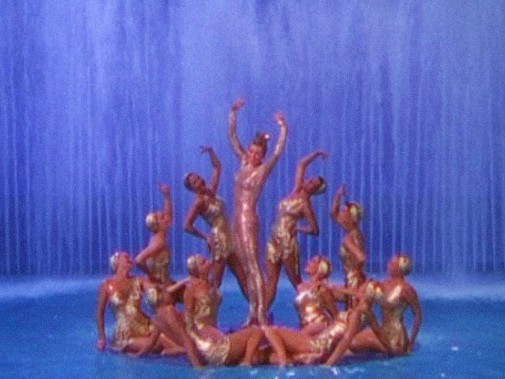
As it turns out, Esther Williams had broken three vertebrae and had to be put in a body cast. While she recovered and eventually returned to the production half a year later, the Million Dollar Mermaid herself would suffer from chronic ailments resulting from this accident. Nevertheless, that number is still on the film. After the fateful dive, Williams emerges from the blue waters, a vision in gold, framed by poised background swimmers. It's a tableau that reverberates with haunting qualities. In those glamorous images, Million Dollar Mermaid encapsulates the unholy miracle of Hollywood moviemaking. Months separate the shots in this number, unimaginable pain and physical trauma. Yet, it all looks seamless and perfect on-screen, an impossible dream materialized in celluloid. The magic of the movies is both beautiful and horrifying, a pool of contradictions we merrily dive in to search for entertainment, dazzlement, pure emotion and heady ideas, imagination unbound.
In 1955, Esther Williams shot her last MGM movie, ending over a decade of box-office-smashing collaborations. It all came to a head when she refused the lead role in a musical remake of The Women, The Opposite Sex, breaching the contract and angering the studio. While her acting career was on its last legs, Williams still found a new home in Universal Pictures. Their first movie was The Unguarded Moment, a suburban thriller concerning lurid sex crimes that saw the star playing a non-musical role that required no swimming. It isn't easy to imagine anything farther from Million Dollar Mermaid in 1950s Hollywood. In any case, Esther William's last film wasn't even a Universal production. In 1963, she starred alongside her husband Fernando Lamas in a Spanish film he directed, Magic Fountain. That movie never got an American release.
As sad as it is to see a star fade away from the Hollywood pantheon, Williams thrived until her death, in 2013. With an athlete's mindset, she always knew her swimming-focused movie career couldn't go on forever and made sure to pursue other avenues for income and independence. Like Kellerman before her, Esther Williams also had a swimwear line. Thankfully, unlike the MGM costumes, none of her designs caused someone to snap their neck.
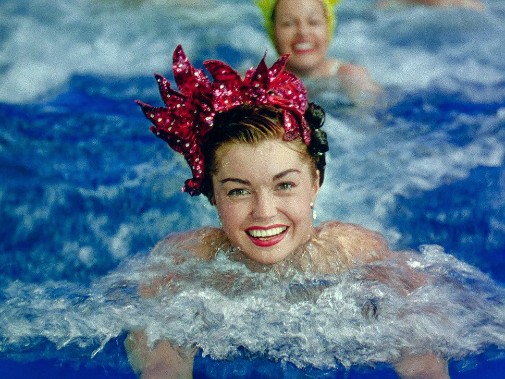
Million Dollar Mermaid is streaming on HBO Max. You can also rent it.



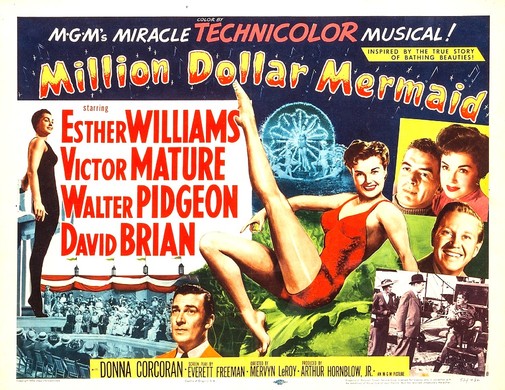
Reader Comments (7)
A decent piece on her iconic work.
Technicolor is one of the coolest things ever invented. Even with a bad copy of the movie on a TV with a bad image, it still manages to dazzle you.
Is this the last one?!... 😢
William was a unique star and her Technicolor films are glorious cinematic fantasies
TCM shows this often, and each time I try to tune in for the Busby Berkeley production numbers.
Angel -- unfortunately yes. I hoped to do DANGEROUS WHEN WET but time is short before the fall festivals begin and we have to move on to the "smackdown" work ;)
Her water choreographies are what movie dreams are made of.